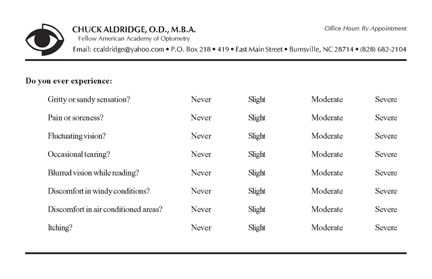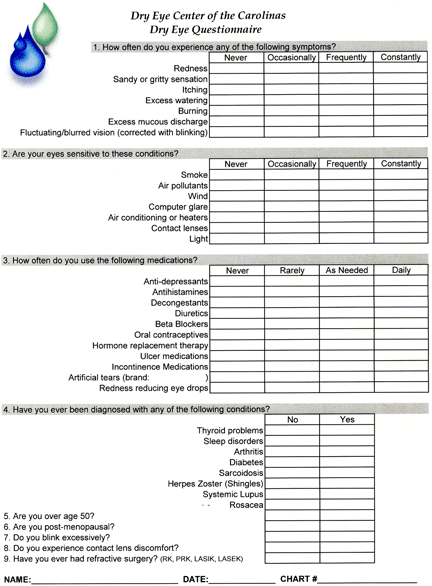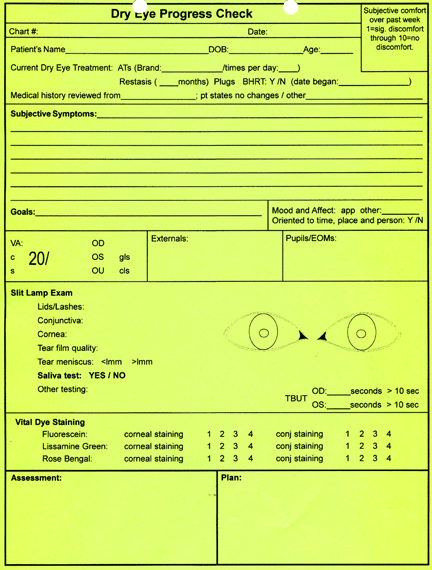So, how can you better identify and more effectively manage your patients with DED? Establish a dry eye center in your existing practice. Though the process does involve some personal commitment and staff training, the creation of a dry eye center is not difficult or expensive. Most importantly, you will be able to provide your patients with DED some relief.

Why does a disease that adversely impacts millions of patients go undiagnosed or misdiagnosed? The answer to this question could be found in the work published by the Delphi Dry Eye panel in September of 2006. The Delphi panel assigned four levels of signs and symptoms to classify the severity of dry eye.4 The researchers determined that patients experienced moderate symptoms but little to no signs of dry eye in the first two levels of disease severity. A more recent study supported these findings and determined that nearly 90% of dry eye patients’ disease can be classified within the first two levels of disease severity.5

Medical training relies heavily on the clinician’s skills to confirm a diagnosis through detecting signs. For example, in glaucoma, we see optic nerve cupping; in ocular infection, we see injection and discharge; and in iritis, we detect flare and cells. These patients may or may not experience symptoms, but their clinical signs are what render the proper diagnosis.
However, when screening for DED, patients may have moderate symptoms but no clinical signs. This situation causes many practitioners to underestimate disease severity or misdiagnose the condition altogether.
Additionally, your patients may not lead you in the correct direction without a thorough interview and history. Their symptoms are usually vague and may be easily trivialized by a busy clinician.
For example, a dry eye patient may mention that his or her eyes hurt when working on the computer, which could result in the prescription of computer-specific spectacle correction. Another dry eye patient may complain of ocular discomfort when playing golf on a windy day or walking on the beach, and leave the office with prescription sunglasses. Even though eye care providers want to help these patients, the chronic and progressive nature of DED could force patients to return for several follow-up visits—or seek help elsewhere.
How do we prevent such misdiagnoses from occurring? We cannot always depend upon clinical signs or patients’ ability to adequately convey their symptoms, so we must establish a way to ask the right questions. Our practice uses two questionnaires: A basic dry eye questionnaire that all patients receive, and a comprehensive questionnaire if the screening tool raises any red flags. If patients are screened for DED and properly questioned, the number of undiagnosed or misdiagnosed dry eye patients already in your practice will shock you.

Create a Dry Eye Center
Once you indentify all of your patients with DED, the question now becomes, “What do you do with them?” Our answer was to create a dry eye center in our existing practice.We believed that our patients with DED needed proper treatment, and we wanted to show that we took their disease and suffering seriously. The process of creating a dry eye center is not difficult or expensive. However, it does involve some personal commitment and staff training.
But, in order to differentiate yourself from other eye care providers, you will need to show your patients that you take the diagnosis and treatment of DED seriously. Patients will sense your commitment when they see DED-specific brochures, information sheets and videos in your waiting areas and exam lanes. Additionally, issuing the Basic Dry Eye Questionnarire to all of your patients will further reinforce your commitment to detecting and eliminating dry eye. Once you confirm a diagnosis of DED, your patients will notice how efficient and unique your specialized practice is.
Delegate Responsibility
The first objection most optometrists voice about creating a dry eye center is the amount of time they need to invest. This opposition is understandable if you attempt to tackle the entire patient education process yourself. If you properly delegate this task, however, the patient care process runs smoothly and creates few additional time demands for you.
Many optometrists no longer perform the optician’s role of selecting and fitting glasses or the contact lens technician’s duty of helping a patient learn how to insert and remove contact lenses. So, the next challenge is to empower your technician to educate patients on disease treatment.
Delegating the task of patient education to a technician involves a personal commitment. There are no shortcuts in this process. The technician must be as informed and as comfortable as you are in sharing this information with the patient. If your technician does not scribe for you, he or she must be brought into the exam room and listen several times when you educate patients on dry eye management. Additionally, you need to listen to and coach the technician as he or she shares their “script” with you. Another useful approach is to have a pharmaceutical representative meet with your technician and provide specific product information, dosing instructions and answer questions.
Keep in mind that you are not delegating your duty of medical diagnosis and treatment recommendations. Once you determine a treatment plan, inform the patient that your technician will reinforce your instructions on proper dry eye treatment as well as information about any prescriptions. You will notice an increase in productivity. And, your patients will likely feel less pressured or rushed by a technician than by a busy doctor with a full lineup of other patients.
Provide Educational Materials
Another important step in establishing a dry eye center is providing your patients with relevant educational materials. You should include promotional brochures, pamphlets and instruction sheets from manufacturers in an educational package. Be sure to include personalized educational information from your dry eye center. This material can be as comprehensive as a booklet or as brief as a letter. Regardless of the format you select, inform your patients about DED, several recommended treatment options and the importance of regular follow-ups.
Most importantly, inform your patients that you will be able to provide them relief as well as future support if DED progresses. This critical message will not only comfort the patient should DED worsen, but also persuade him or her to return for further treatment.
Providing the patient with written information is vital when explaining any diagnosis. The moment after patients are informed that they have a disease, they frequently “zone out” and forget most verbal communication while they begin contemplating the bad news.
If you plan on stocking and selling therapeutic agents and supplements for dry eye, such as fish oil capsules, do not forget to include product information in your education package. When the patient returns for follow-up, he or she will have had an opportunity to review this information and ask any questions. This measure will reduce the amount of time you spend discussing dry eye products at future visits.
Cost and Profitability
• Equipment costs. A common misconception: A lot of expensive testing equipment is required to establish a dry eye center. Actually, nothing could be further from the truth. Level one of dry eye severity has no clinical signs, and level two exhibits just minimal signs, meaning that your diagnosis will result primarily from a good case history. Again, keep in mind that nearly 90% of patients with dry eye disease are categorized into these two levels.5 So, if you depend on special testing to detect clinical signs, you will likely miss nearly all DED diagnoses. The bottom line––a good case history and appropriate questionnaires are the most important clinical tools in your dry eye center.
Always provide your patients with the Brief Dry Eye Questionnaire when they present for a comprehensive eye examination. This will help you to differentiate between potential dry eye and allergy patients. The questionnaire should not be lengthy or cumbersome for the patient to complete—just a few simple questions about itching, burning, grittiness, watering and fluctuating vision are necessary.
Also, be sure to employ a subjective differential scale that forces the patient to rate the degree of symptom severity. This approach is significantly more revealing than asking simple “yes” or “no” questions.
If patients respond positively to these questions and their case histories reveal a higher level of risk, ask more specific questions about their symptoms.
Once you suspect DED, use the Comprehensive Questionnaire to establish baseline information before starting treatment. You can re-administer the Comprehensive Questionnaire periodically at subsequent follow-up exams to help determine treatment success.
• Profitability. Lack of profitability is another misconception about a dry eye center. DED is a medical condition that can be diagnosed, treated and managed under coverage from nearly all insurance plans. And, there’s no need for extra frames, lenses or contact lenses to manage dry eye. But best of all, when treating DED, you reduce your patients’ symptoms and improve their quality of life.

Final Considerations
Now that you know DED affects millions of Americans and does not require expensive equipment or lots of extra time to diagnose and treat, you might want to seriously consider establishing a dry eye center within your practice.
The first step is to create a name and logo. This is important because your dry eye center needs to be “branded.” Even though the dry eye center will be a profit generator that operates within your practice, it needs a separate designation. This shows your commitment to your dry eye patient population and allows for auxiliary marketing.
For example, our practice is the “Aldridge Eye Institute” and we named our dry eye center “Dry Eye Center of the Carolinas.” So, in all of our separate advertising with business cards, newspaper listings and literature, we boldly display “Dry Eye Center of the Carolinas,” with “Aldridge Eye Institute” listed in smaller text beneath it.
How you decide to market your dry eye center depends on your local community and your personal preferences. Some optometrists generate the biggest impact with newspaper ads or radio spots. Other practices garner significant traffic from newsletters and other promotional mailers.
Regardless of the marketing tools you select, do not forget to fully utilize internal methods. If a patient calls to schedule an appointment, have your receptionist ask, “Will this appointment be for the vision clinic or the dry eye center?” Even though most appointments will be for vision examinations, this question creates awareness in your patient population. When you or your staff schedules a dry eye follow-up, make sure to tell your patient, “We’ll schedule to see you back in our dry eye center and see how you are doing.”
You will be pleasantly surprised at how little expense is needed to create a dry eye center. There is no special equipment or exam rooms, and there are only minimal costs for printing questionnaires, business cards and educational literature. The real key to creating a successful dry eye center is the attitude of care and concern you and your employees show your patients during this transformation.
Dr. Aldridge is private practice in Burnsville, N.C. He is also the founder of the Dry Eye Center of the Carolinas.
1. Lemp MA, Baudoui C, Baum J, et al. The definition and classification of dry eye disease: Report of the Definition and Classification Subcommittee of the International Dry Eye WorkShop (2007). Ocular Surface. 2007;5:75-92
2. Schaumberg DA, Sullivan DA, Buring JE, Dana MR. Prevalence of dry eye syndrome among US women. Am J Ophthalmol. 2003 Aug;136(2):318-26.
3. Schiffman RM, Walt JG, Jacobsen G, et al. Utility assessment among patients with dry eye disease. Ophthalmology. 2003 Jul;110(7):1412-9.
4. Behrens A, Doyle JJ, Stern L, et al. Dysfunctional tear syndrome. A Delphi approach to treatment recommendations. Cornea. 2006 Sep;25(8):900-7.
5. Wilson SE, Stulting RD. Agreement of physician treatment practices with the international task force guidelines for diagnosis and treatment of dry eye disease. Cornea. 2007 Apr;26(3):284-9.

